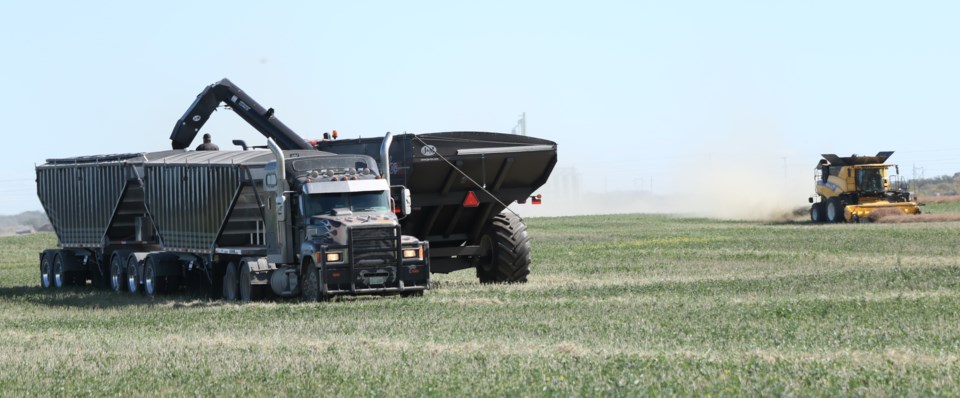REGINA - In five years, Canada’s largest renewable diesel plant will be converting canola oil to renewable fuel, but some experts say this alternative is not the climate solution it is made out to be.
Recently, Federated Co-operatives Ltd., a large gas, food and agricultural supplies retailer, announced plans to build an estimated $2-billion renewable diesel fuel and canola-crushing plant in Regina in partnership with AGT Foods.
The project is part of the co-ops’ goal to reduce greenhouse gas emissions and was dubbed “a big win for the Saskatchewan economy, a win for workers, a win for families ... and a significant win for the environment” by Saskatchewan Premier Scott Moe. But while renewable diesel is often championed as a transition fuel, some experts remain unconvinced it is the best choice to move away from fossil fuels.
Renewable diesel is made from crushing oil from plants, including canola, palms, peanuts, soybeans and sunflower seeds. It can also be produced from waste oils, including used cooking oil from restaurants, giving old french fry grease a new lease on life.
The terms biodiesel and renewable diesel are often used interchangeably. These two fuels produce roughly the same emissions, but renewable diesel is higher quality and can be used up to 100 per cent in vehicles and up to 50 per cent in airplanes, while biodiesel must be blended with regular diesel, said Stephanie Searle, the International Council on Clean Transportation’s (ICCT) fuels program lead.
President and CEO of AGT Foods Murad Al-Katib confirmed the new operation will produce renewable diesel and told Canada’s National Observer that although the plant will be capable of producing sustainable aviation fuel, it plans to focus on fuel for tractors, semis and train locomotives.
Carbon emissions from burning biofuels are about the same as those released from burning oil and gas. The greenhouse gas savings come when the plants used to produce biofuel grow and sequester carbon during photosynthesis, said Searle.
Even those savings vary widely and depend on what organic matter is used and whether emissions from land-use change are factored in. All this makes it difficult to quantify whether biodiesel is a climate-friendly solution.
For canola specifically, some U.S. studies say producing and burning biodiesel results in approximately half the emissions of diesel because of the plant’s ability to sequester carbon.
Other studies have found those gains are outweighed by emissions from farm equipment and land-use changes caused by increased demand for canola as a food source.
The ideal feedstock for biofuel is waste oil because it doesn’t impact food production. However, there isn’t nearly enough of that around, so most biofuel projects require palms, soybeans or, in Canada’s case, canola to be grown and harvested specifically to make fuel. That can mean deforestation and higher emissions, said Searle.
For this reason, she said producing more renewable and biodiesel won’t get us to net-zero emissions by 2050.
Last summer, the Canadian Net-Zero Emissions Accountability Act became law and enshrined Canada’s commitment to either emit no greenhouse gas emissions by 2050 or offset those emissions with things like tree-planting or carbon capture technology.
“We're already pretty much maxing out the benefits that we can get from renewable diesel and biodiesel because most of the potential of waste oils that we could be using, we're already using,” said Searle.
In the U.S., there is not enough feedstock — from waste or crops — to keep pace with the renewable diesel projects planned or underway, and Searle predicts many will be cancelled or operate at low-capacity.
But if even a third of the new projects proceed, demand will skyrocket, and that feedstock must either come out of the food supply, force domestic crops to expand, drive up imports, expand palm oil production in Southeast Asia where deforestation runs rampant or all of the above, a new ICCT report found.
Regina’s future renewable diesel facility and canola processing plant is set to be up and running in 2027.
“The jobs and investment provided by this new plant will have a positive impact for the whole community,” Michael Kram, Conservative MP for Regina-Wascana, said in a statement to Canada’s National Observer. It will also provide “many other benefits,” he added, including developing new “more sustainable industries.”
The NDP’s natural resource critic, Charlie Angus, said “moving workers from one high-emission sector to a low-emission sector (will) be very positive as we move towards a credible plan for transition.”
“If we are looking at a plant that has access to feedstock, is not impacting other areas, (and) will reduce emissions, that, I think could be seen as a definite positive,” he said.
But this is just one step of many, Angus emphasized.
To come anywhere close to reaching net-zero by 2050, Canada needs a serious economic investment plan and a just transition for energy workers, he said.
Because renewable diesel production cannot be scaled up without increasing crop land and interfering with food sources, countries should focus on electrifying cars, trucks and “anything that goes on a road,” said Searle, adding that for machines where batteries aren’t feasible, other options — like hydrogen produced from renewable energy — make more sense.




